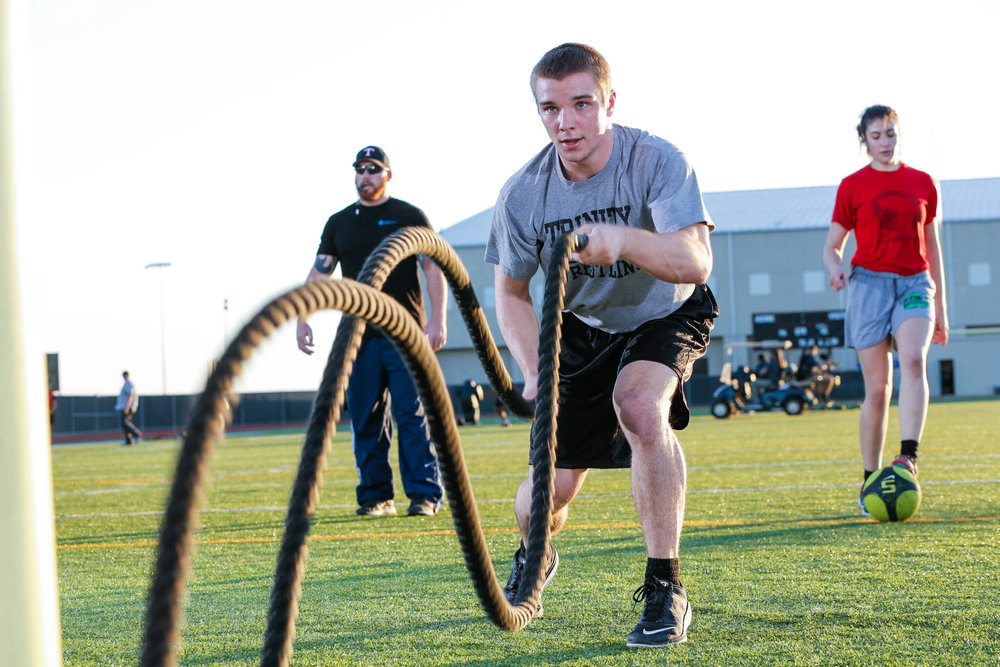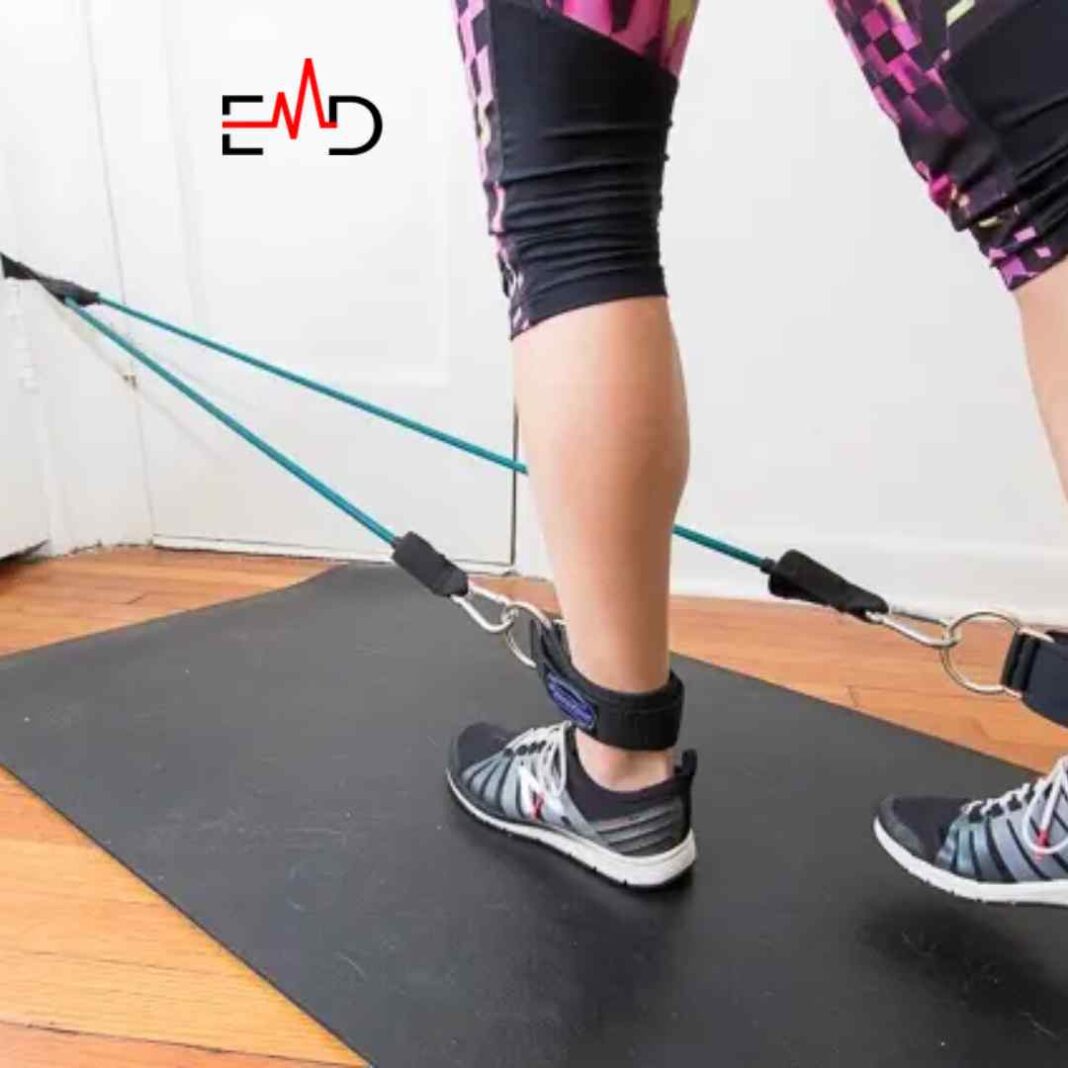Exercise Daily – Boosting your endurance for running takes time, consistency, and a mix of physical and mental strategies. Whether you’re a beginner aiming to run longer or a seasoned runner looking to refine your endurance, here’s a step-by-step approach to building strength and stamina effectively. This comprehensive guide will delve deep into the science of endurance, practical training methods, strength conditioning, and essential tips to help you become a more resilient and efficient runner.
Understanding Endurance and Stamina
Endurance and stamina are often used interchangeably, but they’re slightly different. Both play a critical role in how well you handle longer distances. Endurance is about how long you can sustain a given activity, while stamina is more about the energy level you maintain during physical exertion. Let’s explore how these work specifically when running.
What Is Running Endurance?
Running endurance refers to the ability to keep running without getting overly fatigued. For runners, endurance involves maintaining a steady pace over a long distance and handling both physical and mental challenges that come with prolonged effort. Developing running endurance means your body becomes more efficient at utilizing energy, improving oxygen delivery to muscles, and enhancing your overall cardiovascular health.
The Physiology of Endurance
Understanding the physiological aspects of endurance can help you train more effectively. Endurance training primarily targets the aerobic energy system, which relies on oxygen to produce energy. This system is crucial for sustained activities like long-distance running. Regular endurance training increases the number and size of mitochondria in your muscle cells, enhancing your muscles‘ ability to use oxygen efficiently.
Additionally, endurance training improves your cardiovascular system by increasing your heart’s stroke volume (the amount of blood pumped per beat) and expanding your blood volume. These changes allow for better oxygen transport and utilization, delaying the onset of fatigue.

Differentiating Stamina and Endurance
Stamina is often about burst energy. When you’re sprinting, stamina plays a key role, but endurance is what keeps you going through those long, challenging runs. Think of stamina as a short sprint and endurance as a marathon.
Practical Examples
- Stamina in Action: Imagine you’re participating in a 400-meter sprint. Your body relies heavily on anaerobic energy systems, which do not require oxygen and are used for short, intense bursts of activity. Your ability to maintain high speed over the sprint relies on your stamina.
- Endurance in Action: Contrast this with a half-marathon or marathon. Here, your body primarily uses aerobic energy systems to sustain a steady pace over a longer period. Your endurance allows you to run for hours without succumbing to fatigue.
Building Running Stamina for Beginners
For those just starting, building endurance and stamina gradually is essential. Here’s a roadmap to ease into it without risking injury or burnout.
Start Slow, Build Consistently
One common mistake beginners make is going all out too soon. Start with manageable distances, even if it feels easy, then gradually increase your weekly mileage. The key is consistency over speed.
Creating a Starting Plan
Begin with a run-walk approach, especially if you’re new to running. For example, alternate between running for two minutes and walking for one minute. As your fitness improves, increase the running intervals and decrease the walking periods.
Sample Beginner Plan:
- Week 1: 3 sessions of 20 minutes each, alternating between 2 minutes running and 1 minute walking.
- Week 2: 3 sessions of 25 minutes, alternating between 3 minutes running and 1 minute walking.
- Week 3: 4 sessions of 25 minutes, alternating between 4 minutes running and 1 minute walking.
Gradually increasing the duration and frequency of your runs helps your body adapt without overwhelming it.
The Importance of Rest Days
Rest days aren’t just breaks; they’re crucial for building endurance. Allowing your muscles to recover properly enables you to build strength and prevents overuse injuries.
How Rest Enhances Endurance
When you rest, your body heals microtears in your muscles, strengthening them over time. With improved strength, your endurance improves, too, allowing you to run longer distances without fatigue. Rest also helps replenish glycogen stores, ensuring you have adequate energy for your next run.
Incorporating Active Recovery: On rest days, consider engaging in low-impact activities like walking, yoga, or swimming. These activities promote blood flow and aid recovery without adding additional muscle stress.
Advanced Techniques for Endurance Improvement
Once you’ve developed a base fitness level, you can add advanced methods like interval training and tempo runs to boost your stamina.
Incorporating Interval Training
Interval training, especially high-intensity interval training (HIIT), is a powerful method for quickly building endurance. These short, intense bursts of speed, followed by rest periods, train your heart and lungs, enhancing stamina and endurance.
Benefits of Interval Training
- Increased VO2 Max: Interval training improves your maximum oxygen uptake, allowing your body to utilize oxygen more efficiently.
- Enhanced Lactate Threshold: It raises the point at which lactate accumulates in your bloodstream, delaying fatigue.
- Improved Speed and Power: Regular intervals boost your overall running speed and power, contributing to better endurance.
Designing an Interval Workout
A typical interval session might include:
- Warm-Up: 10 minutes of easy jogging.
- Intervals: 6-8 sets of 400 meters of sprinting at high intensity, followed by 200 meters of walking or slow jogging.
- Cool-Down: 10 minutes of easy jogging or walking.
Adjust the number and intensity of intervals based on your fitness level.
The Power of Tempo Runs
Tempo runs are designed to improve your lactate threshold—when your muscles fatigue. Training at this pace makes it easier to run longer distances without burning out.
Understanding Tempo Runs
A tempo run is typically performed at a “comfortably hard” pace, where you’re working hard but can still maintain the pace without slowing down. This type of training helps your body become more efficient at clearing lactate from your muscles, allowing you to sustain higher intensities for longer periods.
Implementing Tempo Runs
Example Tempo Run:
- Warm-Up: 10 minutes of easy jogging.
- Tempo Segment: 20 minutes at a challenging but sustainable pace (about 80% of your maximum effort).
- Cool-Down: 10 minutes of easy jogging.
As your fitness improves, gradually increase the duration of the tempo segment.

Hill Training for Strength and Endurance
Hill training is another effective method for building strength and endurance. Running uphill engages different muscle groups, improves running form, and boosts cardiovascular fitness.
Benefits of Hill Training
- Strengthens Lower Body Muscles: Hills target your glutes, hamstrings, and calves more intensely than flat surfaces.
- Enhances Running Economy: Uphill running improves your stride efficiency, leading to better performance on flat terrain.
- Increases Cardiovascular Capacity: The increased effort required for hill running elevates your heart rate, enhancing your overall cardiovascular fitness.
Incorporating Hills into Your Training
Hill Workout Example:
- Warm-Up: 10 minutes of easy jogging.
- Hill Repeats: Find a hill with a moderate incline. Run uphill for 1 minute at a strong effort, then walk or jog back down for recovery. Repeat 6-8 times.
- Cool-Down: 10 minutes of easy jogging.
Include hill workouts once a week to complement your regular training routine.
Strength Training for Better Running Performance
Though often overlooked by runners, strength training plays a crucial role in building endurance by supporting muscular endurance and improving running economy.
Exercises to Build Muscular Endurance
Incorporate exercises that target the key muscle groups involved in running. Focus on functional movements that enhance strength and stability.
Essential Strength Exercises
- Lunges: Improve leg strength and balance. Perform walking, reverse, and side lunges to target different muscles.
- Squats: Strengthen your quads, hamstrings, and glutes. Variations like goblet squats and jump squats can add intensity.
- Core Work: A strong core supports better running form and reduces fatigue. Include planks, Russian twists, and bicycle crunches.
- Deadlifts: These exercises enhance posterior chain strength, which is vital for powerful strides. Start with light weights to master form.
Sample Strength Training Routine:
- Warm-Up: 5-10 minutes of dynamic stretching.
- Circuit (3 sets):
- 12 walking lunges per leg
- 15 squats
- 30-second plank
- 12 deadlifts
- Cool-Down: 5 minutes of stretching.
How Strength Training Improves Running Economy
Running economy refers to how efficiently you use energy at a given pace. Strengthening your muscles helps you maintain better form, reduce wasted energy, and run longer without tiring quickly.
Mechanisms of Improved Running Economy
- Enhanced Muscle Fiber Recruitment: Strength training increases the recruitment of muscle fibers, making your movements more efficient.
- Better Biomechanics: Strong muscles support proper alignment and reduce unnecessary movements, leading to more efficient running mechanics.
- Reduced Fatigue: Stronger muscles are less likely to fatigue quickly, allowing you to maintain your pace for longer periods.
Integrating Strength Training: Aim to include strength training 2-3 times a week, focusing on compound movements that engage multiple muscle groups simultaneously.
Training Plans for Long-Distance Running
A structured plan helps you gradually increase mileage while avoiding injury. Let’s look at how to build an effective weekly plan.
Structuring Your Weekly Running Schedule
A balanced weekly running schedule typically includes a mix of short, easy runs, a long run, and either interval or tempo training. This approach ensures you build endurance while allowing adequate recovery.
Example Weekly Schedule
- Monday: Rest or active recovery (e.g., yoga or light swimming)
- Tuesday: Interval training (e.g., 6 x 400m sprints with recovery)
- Wednesday: Easy run (3-5 miles at a comfortable pace)
- Thursday: Tempo run (20 minutes at tempo pace)
- Friday: Rest or cross-training (e.g., cycling or strength training)
- Saturday: Long run (gradually increasing distance each week)
- Sunday: Easy run or active recovery (2-4 miles)
Balancing Mileage and Intensity
Balancing the mileage and intensity in your training plan is crucial for optimal endurance development. Here’s how to manage both aspects effectively:
- Mileage: Gradually increase your weekly mileage by no more than 10% each week to prevent overuse injuries.
- Intensity: Incorporate high-intensity workouts (intervals, tempo runs) 1-2 times per week, ensuring you have sufficient easy runs and rest days to recover.
Sample Plan for Increasing Mileage
Try adding 5-10% more distance to your longest run every week. For instance, if you’re running a 5-mile long run one week, add half a mile the following week. Small increments like this reduce injury risk and improve stamina over time.
Example Progression:
- Week 1: Long run of 5 miles
- Week 2: Long run of 5.5 miles
- Week 3: Long run of 6 miles
- Week 4: Recovery week with a long run of 5 miles
- Week 5: Long run of 6.5 miles
- Week 6: Long run of 7 miles
Incorporate cutback weeks every 4-6 weeks to allow your body to recover and adapt to the increased mileage.

Running Tips for Building Stamina and Avoiding Injuries
Alongside your training, certain tips can keep you strong and healthy, preventing setbacks as you increase endurance.
Selecting the Right Running Shoes
Wearing the right shoes is essential to both comfort and injury prevention. Shoes with proper arch support and cushioning reduce the impact on your joints, allowing you to run longer and improve your endurance.
How to Choose the Best Running Shoes
- Understand Your Foot Type: Determine whether you have flat feet, high arches, or neutral arches. This influences the type of support you need.
- Consider Your Running Style: If you overpronate (roll inward), look for stability shoes. If you underpronate (roll outward), cushioning shoes are ideal.
- Get the Right Fit: Ensure there’s about a thumb’s width of space between your longest toe and the end of the shoe. Shoes should fit snugly but not too tight.
- Replace Regularly: Running shoes typically last between 300-500 miles. Worn-out shoes lose cushioning and support, increasing injury risk.
Visiting a Specialty Running Store: Consider getting professionally fitted at a running store where experts can analyze your gait and recommend suitable shoes.
Common Mistakes to Avoid
Avoiding common pitfalls can make a world of difference in your endurance journey. Here are some of the main errors runners make.
Overtraining and Its Effects on Endurance
Overtraining can lead to burnout and injuries, halting progress. Stick to your plan and resist the urge to overdo it, as consistency beats intensity in building endurance.
Signs of Overtraining:
- Persistent fatigue
- Decreased performance
- Increased susceptibility to injuries
- Irritability or mood swings
- Insomnia or disturbed sleep
Prevention Strategies:
- Follow a structured training plan
- Incorporate rest and recovery days
- Listen to your body and adjust your training intensity as needed
- Ensure adequate nutrition and hydration
Neglecting Warm-Ups and Cool-Downs
Skipping warm-ups and cool-downs can increase injury risk and impair performance. Always start your runs with a proper warm-up to prepare your muscles and end with a cool-down to aid recovery.
Effective Warm-Up Routine:
- 5-10 minutes of easy jogging
- Dynamic stretches like leg swings, high knees, and butt kicks
Effective Cool-Down Routine:
- 5-10 minutes of easy jogging or walking
- Static stretches focusing on major muscle groups
Ignoring Pain and Injuries
Ignoring persistent pain can lead to more serious injuries. If you experience pain that doesn’t subside with rest, seek medical advice promptly.
Common Running Injuries:
- Shin splints
- Plantar fasciitis
- IT band syndrome
- Runner’s knee
- Stress fractures
Management Tips:
- Rest and modify your training
- Use ice and anti-inflammatory measures
- Consult a healthcare professional for persistent issues
Nutrition and Hydration for Endurance
Proper nutrition and hydration are critical components of building and maintaining running endurance. They provide the necessary energy, support muscle function, and aid in recovery.
Fueling Your Runs
Understanding what to eat before, during, and after your runs can significantly impact your performance and endurance.
Pre-Run Nutrition
Consume a balanced meal 2-3 hours before running, rich in complex carbohydrates, moderate in protein, and low in fat and fiber to ensure easy digestion.
Examples:
- Oatmeal with banana and a drizzle of honey
- Whole-grain toast with peanut butter and sliced fruit
- A smoothie with fruits, yogurt, and a handful of spinach
During-Run Nutrition
For runs longer than 60 minutes, consider consuming easily digestible carbohydrates to maintain energy levels. This includes energy gels, sports drinks, or snacks like dried fruit.
Hydration Tips:
- Drink water before and during your run, especially in hot or humid conditions.
- Aim for 4-6 ounces of water every 15-20 minutes during extended runs.
Post-Run Nutrition
After running, focus on replenishing glycogen stores and repairing muscles. A combination of carbohydrates and protein within 30 minutes post-run is ideal.
Examples:
- A protein shake with a banana
- Grilled chicken with quinoa and vegetables
- Greek yogurt with berries and granola
Importance of Hydration
Staying hydrated is essential for maintaining performance and preventing fatigue. Dehydration can impair muscle function, reduce endurance, and increase the risk of cramps and heat-related illnesses.
Daily Hydration Guidelines
- Men: Approximately 3.7 liters (125 ounces) of total water per day
- Women: Approximately 2.7 liters (91 ounces) of total water per day
Adjust your intake based on your activity level, climate, and individual needs.
Electrolyte Balance
Electrolytes like sodium, potassium, and magnesium play vital roles in muscle function and fluid balance. Refill electrolytes during long runs, especially in hot weather, to prevent cramps and maintain performance.
Sources of Electrolytes:
- Sports drinks
- Electrolyte tablets or powders
- Natural sources like bananas, nuts, and seeds

Mental Strategies for Enhancing Endurance
Endurance running is as much a mental challenge as a physical one. Developing mental resilience and effective strategies can help you push through tough moments and achieve your running goals.
Setting Realistic Goals
Setting achievable and specific goals provides direction and motivation. To track progress, break down long-term goals into smaller, manageable milestones.
Examples:
- Long-Term Goal: Complete a marathon in six months.
- Short-term Goals: Increase long run distance by half a mile each week and improve pace by 10 seconds per mile over the next two months.
Visualization Techniques
Visualization involves mentally rehearsing your runs, imagining yourself overcoming challenges, and achieving your goals. This technique can boost confidence and prepare your mind for various scenarios.
How to Practice Visualization
- Find a Quiet Space: Sit comfortably and close your eyes.
- Imagine Your Run: Picture yourself running smoothly, maintaining a steady pace, and feeling strong.
- Overcome Obstacles: Visualize yourself handling difficult moments, such as fatigue or adverse weather, with determination and calm.
- Positive Outcomes: Envision crossing the finish line, achieving your target time, and celebrating your success.
Mindfulness and Focus
Staying present and mindful during your runs can enhance your performance and enjoyment. Focus on your breathing, stride, and surroundings to maintain a positive mindset.
Mindfulness Exercises for Runners
- Breathing Awareness: Pay attention to your breath, ensuring deep and rhythmic inhalations and exhalations.
- Body Scanning: Mentally check in with different parts of your body, noticing any tension or discomfort and adjusting your form accordingly.
- Mantras: Repeat positive affirmations or motivational phrases to keep your spirits high during challenging segments.
Coping with Mental Fatigue
Endurance runs can lead to mental fatigue, making it harder to stay motivated. Develop strategies to cope with these moments and maintain your focus.
Strategies to Combat Mental Fatigue
- Break the Run into Segments: Focus on reaching the next mile marker or landmark rather than the entire distance.
- Music and Podcasts: Listen to your favorite tunes or engaging podcasts to distract and entertain your mind.
- Run with a Partner or Group: Social interaction can provide encouragement and make the run more enjoyable.
- Embrace the Challenge: Shift your mindset to view fatigue as a temporary hurdle that you can overcome, reinforcing your determination.
Recovery and Injury Prevention
Proper recovery and injury prevention are essential for maintaining consistent training and improving endurance.
Importance of Sleep
Sleep is crucial for muscle recovery, hormonal balance, and overall performance. To support your training regimen, aim for 7-9 hours of quality sleep each night.
Tips for Better Sleep
- Establish a Routine: Go to bed and wake up at the same time each day.
- Create a Relaxing Environment: Keep your bedroom cool, dark, and quiet.
- Limit Screen Time: Avoid screens at least an hour before bedtime to reduce blue light exposure.
- Practice Relaxation Techniques: Engage in activities like reading, meditation, or gentle stretching to unwind.
Incorporating Active Recovery
Active recovery involves low-intensity activities promoting blood flow and aiding muscle recovery without significant stress.
Examples of Active Recovery
- Walking: A gentle walk can help flush out lactic acid and reduce muscle stiffness.
- Yoga: Enhances flexibility, reduces tension, and promotes mental relaxation.
- Swimming: Provides a full-body workout with minimal impact on joints.
- Cycling: Low-intensity cycling can help maintain cardiovascular fitness while allowing muscles to recover.
Stretching and Flexibility
Maintaining flexibility through regular stretching can prevent muscle imbalances and reduce injury risk.
Effective Stretching Practices
- Dynamic Stretching: Before running, perform dynamic stretches (e.g., leg swings, and arm circles) to prepare muscles for activity.
- Static Stretching: Incorporate static stretches after running to enhance flexibility and aid recovery (e.g., hamstring stretches, calf stretches).
- Foam Rolling: Use a foam roller to release muscle tightness and improve tissue elasticity.
Listening to Your Body
Pay attention to your body’s signals and adjust your training accordingly. Ignoring signs of fatigue or pain can lead to overuse injuries and setbacks.
When to Take a Break
- Persistent Pain: If pain continues despite rest, consult a healthcare professional.
- Extreme Fatigue: Take an extra rest day if you feel unusually tired or drained.
- Illness: Prioritize recovery over training when you’re sick to prevent prolonged illness and complications.

Running Gear and Accessories
The right gear can enhance your running experience, improve performance, and prevent discomfort.
Choosing the Right Apparel
Wearing appropriate clothing for different weather conditions can make your runs more comfortable and enjoyable.
Tips for Selecting Running Apparel
- Moisture-Wicking Fabrics: Opt for materials that wick sweat away from your skin to keep you dry and prevent chafing.
- Layering: Dress in layers for cold weather, allowing you to adjust your clothing as you warm up.
- Proper Fit: Ensure your clothes fit well and allow a full range of motion without being restrictive.
- Seasonal Considerations: Wear breathable, lightweight fabrics in hot weather and insulated, wind-resistant layers in cold conditions.
Essential Running Accessories
Several accessories can support your training and enhance your performance.
Must-Have Running Accessories
- Hydration Gear: For longer runs, carry water with you using handheld bottles, hydration belts, or hydration packs.
- GPS Watch: Track your distance, pace, and heart rate to monitor your progress and stay on target.
- Reflective Gear: Ensure visibility during early morning or evening runs with reflective clothing and accessories.
- Sun Protection: Wear a hat and apply sunscreen to protect your skin from harmful UV rays.
- Compression Gear: Consider compression socks or sleeves to improve circulation and reduce muscle fatigue.
Technology and Apps
Utilize technology and mobile apps to optimize your training and stay motivated.
Recommended Running Apps
- Strava: Track your runs, analyze performance metrics, and connect with a community of runners.
- Runkeeper: Offers personalized training plans, goal setting, and progress tracking.
- Nike Run Club: Provides guided runs, coaching plans, and motivational challenges.
- MapMyRun: You can map your routes, log workouts, and access training tips.
Motivation and Community Support
Staying motivated and finding a supportive community can significantly impact your endurance training journey.
Finding a Running Community
Joining a running group or community can provide encouragement, accountability, and social interaction.
Benefits of a Running Community
- Shared Goals: Running with others who share your goals can boost motivation and push you to achieve more.
- Social Interaction: Enjoy the camaraderie and make new friends who support your running journey.
- Accountability: Regular group runs help you stay consistent with your training schedule.
- Knowledge Sharing: Learn from experienced runners who can offer tips, advice, and insights.
How to Join a Running Community
- Local Running Clubs: You can find running clubs in your area through community centers, gyms, or online platforms.
- Social Media Groups: Join Facebook or online running and endurance training forums.
- Race Events: Participate in local races and events to meet fellow runners and join the running community.
Staying Motivated
Maintaining motivation over the long term is essential for building endurance. Here are strategies to keep your enthusiasm high.
Setting Diverse Goals
Having various goals can keep your training interesting and provide multiple sources of motivation.
Types of Goals:
- Performance Goals: Aim to achieve specific times or distances.
- Process Goals: Focus on improving aspects of your training, such as increasing your weekly mileage or perfecting your running form.
- Outcome Goals: Set goals related to race outcomes, such as finishing a marathon or qualifying for a specific event.
Rewarding Yourself
Incentivize your training by rewarding yourself for achieving milestones. Rewards, such as a favorite treat, new running gear, or a relaxing massage, can be small.
Tracking Progress
Keeping a training log or using a running app to track your progress can provide a sense of accomplishment and highlight improvements over time.
Benefits of Tracking:
- Visual Progress: Seeing your distance, speed, and endurance improvements can boost confidence.
- Identifying Patterns: Analyze your training data to identify what works best for you and adjust accordingly.
- Staying Accountable: Regularly updating your progress keeps you committed to your goals.
Overcoming Plateaus
Hitting a training plateau can be frustrating, but there are ways to break through and improve your endurance.
Strategies to Overcome Plateaus
- Vary Your Workouts: Introduce new training methods, such as hill repeats, intervals, or cross-training, to challenge your body in different ways.
- Increase Intensity: Gradually increase the intensity of your workouts by running faster or incorporating more challenging terrain.
- Prioritize Recovery: Ensure adequate rest and recovery to allow your body to adapt and grow stronger.
- Reassess Goals: Set new or adjusted goals to reignite your motivation and give you a fresh focus.

Conclusion
Building endurance is a journey that requires patience, strategy, and a focus on both body and mind. By gradually incorporating strength training, interval workouts, and consistent running, you’ll improve your stamina and overall running performance. Remember, endurance isn’t built overnight, but each run takes you closer to your goals. Embrace the process, stay committed, and celebrate your progress along the way.
FAQs – Techniques for Improving Endurance in Runners
Q: How many times a week should I train to build endurance?
A: For beginners, aim for 3-4 days per week and gradually increase as your fitness improves. Consistency is key to building endurance without risking injury.
Q: What’s the best way to improve running stamina?
A: Combining interval and tempo training with long, steady runs is ideal for enhancing stamina. These varied workouts challenge your cardiovascular system and muscle endurance.
Q: Do I need to change my diet to build endurance?
A: A balanced diet with adequate protein, carbohydrates, and hydration supports stamina and recovery. Proper nutrition fuels your runs and aids in muscle repair and energy replenishment.
Q: Is rest really important for endurance training?
A: Yes, rest allows your muscles to recover, reduces the risk of injuries, and improves overall stamina. Incorporate rest days and active recovery into your training plan.




